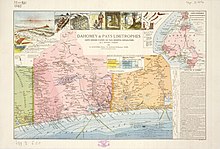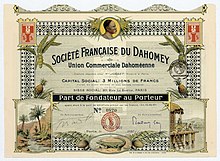History of Benin
The history of Benin encompasses developments in the territory of the Republic of Benin from the French colonial era to the present.
French colony
The area of the current state of Benin formed the largest part of the kingdom of Dahomey from the 17th century until it was occupied by the French on behalf of Napoleon Bonaparte in 1805 and was incorporated as a colony of the French Empire . The colony was abandoned in 1814 when it was defeated by Great Britain in the British-French colonial conflict. 1863 took over the Second Empire , the protectorate over the kingdom of Porto-Novo in the south of the country, 1868 Cotonou . In the years after 1879 the occupation of the northern areas began.
After the conquest of the Kingdom of Dahomey in the 1890s, today's Benin was part of French West Africa with the capital Dakar from 1899 to 1960 . The last King Béhanzin was deported to the Caribbean island of Martinique . The conquest was largely carried out by troops from Senegal . The port of Cotonou was expanded to develop the country. During the Second World War , the colony initially remained loyal to the Vichy government and fell to de Gaulle's Free France in November 1942 .
1945 to 1960
With the constitution for the fourth republic , the overseas holdings in the framework of the Union française received MPs in the National Assembly and in the Senate in Paris . Like the other territories, Dahomey received its own parliament. After the Constitution of the Fifth Republic was adopted on December 4, 1958, Dahomey became an autonomous republic. Sourou-Migan Apithy became head of government in May 1958 , before being replaced by Coutoucou Hubert Maga in May 1959 .
The development of women's suffrage was determined by the conditions in France. According to the Loi Lamine Guèye of 1946, all citizens had the right to vote in elections to the French parliament and also in local elections. The right to stand as a candidate was not expressly mentioned in the law, but it was not excluded either. In French West Africa , to which Dahomey belonged, there was no two-tier suffrage in the elections to the Paris parliament, as in other French colonies, but there was for all local elections. In 1956 the loi-cadre Defferre was introduced, which in Article 10 guaranteed the general right to be active as a candidate. When the country gained independence in 1960, this legal situation was confirmed.
MPs in Paris
- October 21, 1945 for Dahomey and Togo : Sourou-Migan Apithy. For the resident Europeans Francis Marie Aupiais, after his death on December 14, 1945 Jacques Joseph Pierre Marie Bertho
- June 2, 1946 both re-elected
- November 10, 1946 Apithy re-elected for Dahomey, Togo's own constituency
- 17 June 1951 Apithy re-elected, plus Coutoucou Hubert Maga
- January 2, 1956 both re-elected
independence
1960 to 1972
At the time of independence on August 1, 1960, the population of the Dahomey Republic was around 1.8 million. As a member of the West African Economic and Monetary Union, Dahomey stayed with the CFA franc as its currency.
In 1961 Dahomey had a brief conflict with Portugal : The small Portuguese base São João Baptista d'Ajudá near Ouidah , which had been Portuguese since 1680 , was evacuated by the Portuguese after an ultimatum and taken over by Dahomey on August 1, 1961. Except for an American journalist in the early 1950s, no one is said to have voluntarily visited this outpost.
In the years up to 1972, politics was dominated by three politicians: the former head of government Sourou-Migan Apithy from Porto Novo, his successor and rival Maga as representative of the north and Justin Ahomadegbé-Tomêtin . In addition, Chief of Staff Christophe Soglo played an important role in the army , and after 1967 his successor, Iropa Maurice Kouandété . The economic situation and conflicts between the ethnic groups and the regions of the country led to a large number of coups in the first twelve years, even by African standards.
In 1960 Maga became president with Apithy as vice-president. At the beginning of 1961, the party landscape was brought into line and the Parti Dahoméen de l'Unité (PDU) was established as a unified party . After serious unrest, Maga resigned on October 27, 1963. After his Vice Apithy formally headed the state for a day, Colonel Soglo took power as chairman of a three-man military junta . After drafting a new constitution, which was confirmed in a referendum , Apithy took over the presidency on January 25, 1964. Aptithy resigned in November 1965 to make way for a new government under previous Speaker of Parliament Tahirou Congacou . He was overthrown on December 22nd, 1965 by Soglo, now a general, who himself took over the presidency.
His presidency was also short: on December 19, 1967, he was overthrown by a group of younger officers under Kouandété. In 1968 the military appointed the civilian Émile Derlin Henri Zinsou as president, who was overthrown in December 1969 by the next coup, again under Kouandété's leadership. As chairman of the military council, Lieutenant Colonel Paul-Émile de Souza became head of state.
Parliamentary and presidential elections were planned for 1970. The disagreement between the politicians from the north and south of the country and the fear of a civil war led to the fact that these elections were canceled on April 3, 1970. The candidates (Apithy, Maga, Ahomadegbé-Tomêtin and Zinsou) then negotiated and agreed on a three-member presidential council, the three members of which were to replace themselves at the head of the state. This included the aforementioned Apithy, Maga and Ahomadegbé-Tomêtin. On April 24, 1970, the three agreed that Maga should take over the first two-year term. Maga replaced de Souza as president on May 7, 1970. Ahomadegbé-Tomêtin took over the second term of office on May 7, 1972 as agreed. The regulation became obsolete when Major Mathieu Kérékou staged a coup on October 26, 1972 and had the trio imprisoned until 1981.
1972 to 1991
Under Kérékou, the country embarked on a Marxist-Leninist course and maintained close ties with the Soviet Union , and the country was converted into the People's Republic of Benin . With the Parti de la révolution populaire du Bénin (PRPB) a new unity party was founded. In keeping with the fashion of the times, the country was renamed Benin with effect from December 1, 1975 , after the former Kingdom of Benin , which, however, lay in southwestern Nigeria . In early 1977 an attempt by a group of mercenaries led by Bob Denard to overthrow Kérékou failed (Denard was sentenced to five years in prison in 1993 in Paris). On August 26, 1977, the country received a new constitution. Given the circumstances, Kérékou's confirmation as president in the 1979, 1984 and 1989 elections was a matter of form.
Since the mid-1980s, the Soviet Union has reduced its contributions to its allies in the Third World, which also had consequences for Benin. With the dissolution of the Eastern Bloc , Kérékou reoriented and introduced a multi-party system by 1991 . After unrest due to the poor economic situation, a national conference was convened at the end of 1989. On March 9, 1990, a council (Haut Conseil pour la République) was formed as the provisional supreme body of the legislature. This council included the former heads of state Maga, Ahomadegbé-Tomêtin, Congacou and Zinsou. They appointed the former director of the World Bank Nicéphore Dieudonné Soglo as prime minister of a transitional government.
In the March 1991 elections, Kérékou was defeated by Soglo, who took office on April 4, 1991. Towards the end of his rule he had already turned away from socialism and taken the first steps towards a market economy.
Since 1991
Benin has been a democracy since 1991, despite occasional disagreements in elections . In 1996, around 80 authorized parties were counted. In the April 1996 elections, Kérékou was again able to prevail against Soglo with 52.49% of the vote. In 2001 he won again, with allegations of election fraud. Foreign election observers spoke of inconsistencies, but assumed that the will of the voters was reflected in the result. In March 2003 the parties supporting Kérékou won a majority in parliament. According to the constitution, Kérékou was not allowed to run again as president in 2006.
Web links
- History of Benin near Beninensis ( Memento of March 5, 2016 in the Internet Archive ) (French)
- Chronology 1960 to 2000 ( Memento from July 28, 2003 in the Internet Archive ) (French)
- Election results in African Elections Database (English)
- Entry by the Colonial Archives of Benins as a UNESCO World Heritage Site
Individual evidence
- ^ Franz Ansperger: Politics in Black Africa: The modern political movements in Africa with French characteristics. Springer Fachmedien Wiesbaden GmbH Wiesbaden, 1961, p. 73.
- ^ Mart Martin: The Almanac of Women and Minorities in World Politics. Westview Press Boulder, Colorado, 2000, p. 39.
- ↑ June Hannam, Mitzi Auchterlonie, Katherine Holden: International Encyclopedia of Women's Suffrage. ABC-Clio, Santa Barbara, Denver, Oxford 2000, ISBN 1-57607-064-6 , p. 9.
- ↑ Dahomey Announces Its Name Will Be Benin. The New York Times, December 1, 1975, accessed June 24, 2018 .



